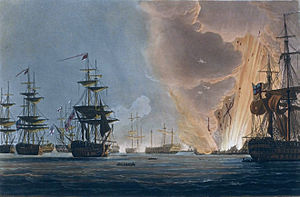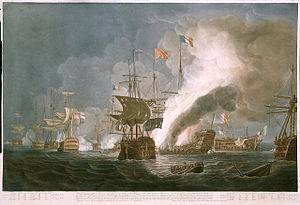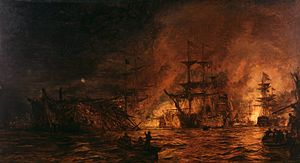| French ship Orient (1791) | |
|---|---|
 Battle of the Nile, August 1st 1798 at 10 pm, by Thomas Luny. Orient is depicted aflame at the centre-left. | |
| Career (France) | |
| Builder: | Toulon Arsenal |
| Laid down: | May 1790 |
| Launched: | 20 July 1791 |
| Commissioned: | August 1793 |
| Out of service: | August 1798 |
| Renamed: | originally Dauphin-Royal, renamed Sans-Culotte in September 1792, and finally renamed Orient in May 1795. |
| Fate: | Destroyed by explosion of her magazine at the Battle of the Nile, August 1798 |
| General characteristics | |
| Displacement: | 5 095 tonnes |
| Length: | 65,18 metres (196,6 French feet) |
| Beam: | 16,24 metres (50 French feet) |
| Draught: | 8,12 metres (25 French feet) |
| Propulsion: | sail, 3 265 m² |
| Complement: | 1 079 men |
| Armament: |
120 guns: 18 x 8-pounder guns, 6 x 36-pounder carronades |
| Armour: | Wood |
The Orient was an Océan-class 118-gun ship of the line of the French Navy, famous for her role as flagship of the French fleet at the Battle of the Nile in August 1798, and for her spectacular destruction that day when her magazines detonated. The event was commemorated by numerous paintings and poems.
Career[]
The ship was laid down in Toulon, and launched on 20 July 1791 under the name Dauphin Royal. In September 1792, after the advent of the French First Republic, and not yet commissioned, she was renamed Sans-Culotte, in honour of the Sans-culottes. On 14 March 1795, she took part in the Battle of Genoa as flagship of rear-admiral Martin. She covered the rear of the French line, exchanging fire with HMS Bedford and HMS Egmont, but lost contact with her fleet during the night and was thus prevented from taking further part in the action. In May 1795, Sans-Culotte was again renamed as a consequence of the Thermidorian Reaction, and took her best-known name of Orient. In 1798, Orient was appointed flagship of the squadron tasked with the invasion of Egypt, under Admiral Brueys, with captain Casabianca as his flag officer.[2] Orient also ferried the chiefs of the Armée d'Égypte, notably general Bonaparte. The fleet avoided the British blockade and captured Malta before landing troops in Egypt. Afterwards, it anchored in a bay east of Alexandria, in a purportedly strong defensive position. Nelson's squadron discovered the fleet on 1 August, and he attacked the next day, starting the Battle of the Nile. Nelson had his units sail between the shore and the French ships at anchor, picking them one by one in a cross-fire. Orient eventually came under fire from five ships, caught fire and exploded spectacularly at 22:30.[3]
The number of casualties is disputed: the British reported 70 survivors, reflecting the numbers they rescued aboard their ships, and inferring considerable losses over the 1130-man complement; however, the crew was far from complete at the time of the battle and a number of survivors might have been picked up by French ships. Contre-amiral Decrès reported as many as 760 survivors.[4]
The explosion is also often presented as a turning point of the battle; as a matter of fact, the battle was won by the British when their reinforcements arrived at nightfall, and the interruption of the fighting was brief after the explosion.[4]
Legacy[]
The explosion of Orient struck the public of the time, both because of its historical signification and of its spectacular aesthetics. Its romantic load was compounded by the presence aboard of Captain Casabianca's young son, who died in the wreck; this particular detail inspired Felicia Hemans's poem Casabianca:
The boy stood on the burning deck
Whence all but he had fled;
The flame that lit the battle's wreck
Shone round him o'er the dead
Shortly after the battle, Nelson was presented with a coffin carved from a piece of the main mast of Orient, which had been taken back to England for this purpose; he was put inside this coffin after his death at the Battle of Trafalgar.
Gallery[]
<templatestyles src="Template:Gallery/styles.css"></templatestyles>
- Depictions of the explosion of the Orient
References[]
- ↑ "French first rate ship of the line Dauphin Royal (1791)". threedecks.org. http://www.threedecks.org/index.php?display_type=show_ship&id=1880. Retrieved 9 December 2012.
- ↑ "Admiral Nelson's stunning victory over the French Fleet in 1798.". www.britishbattles.com. http://www.britishbattles.com/waterloo/battle-nile.htm. Retrieved 9 December 2012.
- ↑ Millar, Stephen. "French Naval Order of Battle at Aboukir Bay (Battle of the Nile): 1–2 August 1798". www.napoleon-series.org. http://www.napoleon-series.org/military/battles/Egypt/Nile/c_nile.html. Retrieved 9 December 2012.
- ↑ 4.0 4.1 Mioque, Nicolas. "La perte des 118 canons L’Orient (1798) et L’Impérial (1806)". troisponts. http://troisponts.wordpress.com/2012/05/08/la-perte-des-118-canons-lorient-1798-et-limperial-1806/. Retrieved 19 March 2012.
- Dictionnaire de la flotte de guerre française de 1617 à nos jours, Jean-Michel Roche
The original article can be found at French ship Orient (1791) and the edit history here.






